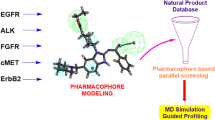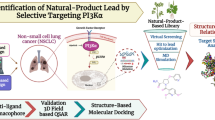Abstract
Human neutrophil elastase inhibitors (HNE-Is) have been recently implicated in inflammatory diseases. Accordingly, we applied a drug discovery workflow to unveil novel inhibitory HNE leads via combining pharmacophore modeling, quantitative structure–activity relationship (QSAR) analysis, and in silico screening. We employed the pharmacophoric models and associated QSAR equation to screen the National Cancer Institute (NCI) list of compounds. Virtual screening identified 14 novel leads from NCI compounds. The most potent hit 126 exhibited 93 % inhibition at 10 μM.







Similar content being viewed by others
References
Abdula AM, Khalaf RA, Mubarak MS, Taha MO (2011) Discovery of new beta-d-galactosidase inhibitors via pharmacophore modeling and QSAR analysis followed by in silico screening. J Comput Chem 32:463–482
Abu Hammad AM, Taha MO (2009) Pharmacophore modeling, quantitative structure-activity relationship analysis, and shape-complemented in silico screening allow access to novel influenza neuraminidase inhibitors. J Chem Inf Model 49(4):978–996
Abu Hammad AM, Afifi FU, Taha MO (2007) Combining docking, scoring and molecular field analyses to probe influenza neuraminidase–ligand interactions. J Mol Graph Model 26(2):443–456
Abu Khalaf R, Abu Sheikha G, Bustanji Y, Taha MO (2010) Discovery of new cholesteryl ester transfer protein inhibitors via ligand-based pharmacophore modeling and QSAR analysis followed by synthetic exploration. Eur J Med Chem 45(4):1598–1617
Al-Masri IM, Mohammad MK, Taha MO (2008) Discovery of DPP IV inhibitors by pharmacophore modeling and QSAR analysis followed by in silico screening. ChemMedChem 3(11):1763–1779
Al-Nadaf A, Abu Sheikha G, Taha MO (2010) Elaborate ligand-based pharmacophore exploration and QSAR analysis guide the synthesis of novel pyridinium-based potent beta-secretase inhibitory leads. Bioorg Med Chem 18(9):3088–3115
Al-Sha’er MA, Taha MO (2010a) Discovery of novel CDK1 inhibitors by combining pharmacophore modeling, QSAR analysis and in silico screening followed by in vitro bioassay. Eur J Med Chem 45(9):4316–4330
Al-Sha’er MA, Taha MO (2010b) Elaborate ligand-based modeling reveals new nanomolar heat shock protein 90α inhibitors. J Chem Inf Model 50(9):1706–1723
Belaaouaj A, McCarthy R, Baumann M, Gao Z, Ley TJ, Abraham SN, Shapiro SD (1998) Mice lacking neutrophil elastase reveal impaired host defense against gram negative bacterial sepsis. Nat Med 4(5):615–618
Bernstein PR, Edwards PD, Williams JC (1994) Inhibitors of human leukocyte elastase. Prog Med Chem 31:59–120
Bersuker IB, Bahçeci S, Boggs JE (2000) In: Güner OF (ed) Pharmacophore perception, development, and use in drug design. International University Line, La Jolla
Bode W, Meyer E Jr, Powers JC (1989) Human leukocyte and porcine pancreatic elastase: X-ray crystal structures, mechanism, substrate specificity, and mechanism-based inhibitors. Biochemistry 28(5):1951–1963
CATALYST4.11 (2005) Users’ manual, Accelrys Software Inc., San Diego
CERIUS2 (2005) QSAR users’ manual, version 4.10. Accelrys Inc., San Diego
Clement OO, Mehl AT (2000) HipHop: pharmacophores based on multiple common-feature alignment. In: Gűner OF (ed) Pharmacophore perception, development, and use in drug design. International University Line, La Jolla, pp 69–84
Crocetti L, Schepetkin IA, Cilibrizzi A, Graziano A, Vergelli C, Giomi D, Khlebnikov AI, Quinn MT, Giovannoni MP (2013) Optimization of N-benzoylindazole derivatives as inhibitors of human neutrophil elastase. J Med Chem 56:6259–6272
Discovery Studio 2.5.5 (2010) User Guide, Accelrys Inc., San Diego
Doring G (1999) Serine proteinase inhibitor therapy in alpha(1)-antitrypsin inhibitor deficiency and cystic fibrosis. Pediatr Pulmonol 28(5):363–375
Fischer R (1966) The principle of experimentation illustrated by a psycho-physical experiment. Hafner, New York
Fitch PM, Roghanian A, Howie SE, Sallenave JM (2006) Human neutrophil elastase inhibitors in innate and adaptive immunity. Biochem Soc Trans 34(Pt 2):279–282
Guay C, Laviolette M, Tremblay GM (2006) Targeting serine proteases in asthma. Curr Top Med Chem 6(4):393–402
Guner O, Clement O, Kurogi Y (2004) Pharmacophore modeling and three dimensional database searching for drug design using catalyst: recent advances. Curr Med Chem 11:2991–3005
Habash M, Taha MO (2011) Ligand-based modelling followed by synthetic exploration unveil novel glycogen phosphorylase inhibitory leads. Bioorg Med Chem 19(16):4746–4771
Inoue Y, Omodani T, Shiratake R, Okazaki H, Kuromiya A, Kubo T, Sato F (2009) Development of a highly water-soluble peptide-based human neutrophil elastase inhibitor; AE-3763 for treatment of acute organ injury. Bioorg Med Chem 17(21):7477–7486
Irwin JJ, Shoichet BK (2005) ZINC: a free database of commercially available compounds for virtual screening. J Chem Inf Model 45(1):177–182
Jacobsson M, Liden P, Stjernschantz E, Bostrom H, Norinder U (2003) Improving structure-based virtual screening by multivariate analysis of scoring data. J Med Chem 46(26):5781–5789
Kirchmair J, Markt P, Distinto S, Wolber G, Langer T (2008) Evaluation of the performance of 3D virtual screening protocols: RMSD comparisons, enrichment assessments, and decoy selection: what can we learn from earlier mistakes? J Comput Aided Mol Des 22(3–4):213–228
Krovat EM, Langer T (2003) Non-peptide angiotensin II receptor antagonists: chemical feature based pharmacophore identification. J Med Chem 46(5):716–726
Kurogi Y, Guner OF (2001) Pharmacophore modeling and three-dimensional database searching for drug design using catalyst. Curr Med Chem 8(9):1035–1055
Lee WL, Downey GP (2001) Leukocyte elastase: physiological functions and role in acute lung injury. Am J Respir Crit Care Med 164(5):896–904
Li H, Sutter J, Hoffmann R (2000) In: Güner OF (ed) Pharmacophore perception, development, and use in drug design. International University Line, La Jolla, pp 173–189
Lipinski CA, Lombardo F, Dominy BW, Feeney PJ (2001) Experimental and computational approaches to estimate solubility and permeability in drug discovery and development settings. Adv Drug Deliv Rev 46(1–3):3–26
Meyer-Hoffert U, Wingertszahn J, Wiedow O (2004) Human leukocyte elastase induces keratinocyte proliferation by epidermal growth factor receptor activation. J Invest Dermatol 123(2):338–345
Nenan S, Boichot E, Lagente V, Bertrand CP (2005) Macrophage elastase (MMP-12): a pro-inflammatory mediator? Mem Inst Oswaldo Cruz 100(Suppl 1):167–172
Ohbayashi H (2002) Novel neutrophil elastase inhibitors as a treatment for neutrophil-predominant inflammatory lung diseases. IDrugs 5(9):910–923
Ohmoto K, Okuma M, Yamamoto T, Kijima H, Sekioka T, Kitagawa K, Yamamoto S, Tanaka K, Kawabata K, Sakata A, Imawaka H, Nakai H, Toda M (2001) Design and synthesis of new orally active inhibitors of human neutrophil elastase. Bioorg Med Chem 9(5):1307–1323
Owen CA, Campbell MA, Boukedes SS, Campbell EJ (1997) Cytokines regulate membrane-bound leukocyte elastase on neutrophils: a novel mechanism for effector activity. Am J Physiol 272(3 Pt 1):L385–L393
Pham CT (2006) Neutrophil serine proteases: specific regulators of inflammation. Nat Rev Immunol 6(7):541–550
Poptodorov K, Luu T, Langer T, Hoffmann R, Hoffmann RD (2006) In: Methods and principles in medicinal chemistry pharmacophores and pharmacophores searches. Wiley-VCH, Weinheim
Rijken F, Kiekens RC, Bruijnzeel PL (2005) Skin-infiltrating neutrophils following exposure to solar-simulated radiation could play an important role in photoaging of human skin. Br J Dermatol 152(2):321–328
Rijken F, Kiekens RC, van den Worm E, Lee PL, van Weelden H, Bruijnzeel PL (2006) Pathophysiology of photoaging of human skin: focus on neutrophils. Photochem Photobiol Sci 5(2):184–189
Rogalski C, Meyer-Hoffert U, Proksch E, Wiedow O (2002) Human leukocyte elastase induces keratinocyte proliferation in vitro and in vivo. J Invest Dermatol 118(1):49–54
Shahin R, Taha MO (2012) Elaborate ligand-based modeling and subsequent synthetic exploration unveil new nanomolar Ca2+/calmodulin-dependent protein kinase II inhibitory leads. Bioorg Med Chem 20:377–400
Shahin R, Alqtaishat S, Taha MO (2012) Elaborate ligand-based modeling reveal new submicromolar rho kinase inhibitors. J Comput Aided Mol Des 26:249–266
Shapiro SD (2002) Neutrophil elastase: path clearer, pathogen killer, or just pathologic? Am J Respir Cell Mol Biol 26(3):266–268
Shreder KR, Cajica J, Du L, Fraser A, Hu Y, Kohno Y, Lin EC, Liu SJ, Okerberg E, Pham L, Wu J, Kozarich JW (2009) Synthesis and optimization of 2-pyridin-3-yl-benzo[d][1,3]oxazin-4-one based inhibitors of human neutrophil elastase. Bioorg Med Chem Lett 19(16):4743–4746
Smellie A, Teig SL, Towbin P (1995a) Poling: promoting conformational variation. J Comput Chem 16:171–187
Smellie A, Kahn SD, Teig SL (1995b) Analysis of conformational coverage: 2. Application of conformational models. J Chem Inf Comput Sci 35:295–304
Sprague PW, Hoffmann R, Van de Waterbeemd H, Testa B, Folkers G (1997) CATALYST pharmacophore models and their utility as queries for searching 3D databases. Curr Tools Med Chem 223–240
Starcher B, O’Neal P, Granstein RD, Beissert S (1996) Inhibition of neutrophil elastase suppresses the development of skin tumors in hairless mice. J Invest Dermatol 107(2):159–163
Suaifan GA, Shehadehh M, Al-Ijel H, Taha MO (2012) Extensive ligand-based modeling and in silico screening reveal nanomolar inducible nitric oxide synthase (iNOS) inhibitors. J Mol Graph Model 37:1–26
Sun Z, Yang P (2004) Role of imbalance between neutrophil elastase and alpha 1-antitrypsin in cancer development and progression. Lancet Oncol 5(3):182–190
Sutter J, Hoffmann RD, Li H, Waldman M (2000) Pharmacophore perception, development, and use in drug design effect of variable weights and tolerances on predictive model generation. International University Line, La Jolla
Taha MO, Bustanji Y, Al-Bakri AG, Yousef AM, Zalloum WA, Al-Masri IM, Atallah N (2007) Discovery of new potent human protein tyrosine phosphatase inhibitors via pharmacophore and QSAR analysis followed by in silico screening. J Mol Graph Model 25(6):870–884
Taha MO, Atallah N, Al-Bakri AG, Paradis-Bleau C, Zalloum H, Younis KS, Levesque RC (2008a) Discovery of new MurF inhibitors via pharmacophore modeling and QSAR analysis followed by in silico screening. Bioorg Med Chem 16(3):1218–1235
Taha MO, Bustanji Y, Al-Ghussein MA, Mohammad M, Zalloum H, Al-Masri IM, Atallah N (2008b) Pharmacophore modeling, quantitative structure-activity relationship analysis, and in silico screening reveal potent glycogen synthase kinase-3beta inhibitory activities for cimetidine, hydroxychloroquine, and gemifloxacin. J Med Chem 51(7):2062–2077
Taha MO, Dahabiyeh LA, Bustanji Y, Zalloum H, Saleh S (2008c) Combining ligand-based pharmacophore modeling, quantitative structure-activity relationship analysis and in silico screening for the discovery of new potent hormone sensitive lipase inhibitors. J Med Chem 51(20):6478–6494
Triballeau N, Acher F, Brabet I, Pin JP, Bertrand HO (2005) Virtual screening workflow development guided by the “receiver operating characteristic” curve approach. Application to high-throughput docking on metabotropic glutamate receptor subtype 4. J Med Chem 48(7):2534–2547
Tsuji N, Moriwaki S, Suzuki Y, Takema Y, Imokawa G (2001) The role of elastases secreted by fibroblasts in wrinkle formation: implication through selective inhibition of elastase activity. Photochem Photobiol 74(2):283–290
Veber DF, Johnson SR, Cheng HY, Smith BR, Ward KW, Kopple KD (2002) Molecular properties that influence the oral bioavailability of drug candidates. J Med Chem 45(12):2615–2623
Verdonk ML, Berdini V, Hartshorn MJ, Mooij WT, Murray CW, Taylor RD, Watson P (2004) Virtual screening using protein-ligand docking: avoiding artificial enrichment. J Chem Inf Comput Sci 44(3):793–806
Williams SE, Brown TI, Roghanian A, Sallenave JM (2006) SLPI and elafin: one glove, many fingers. Clin Sci (Lond) 110(1):21–35
Witko-Sarsat V, Rieu P, Descamps-Latscha B, Lesavre P, Halbwachs-Mecarelli L (2000) Neutrophils: molecules, functions and pathophysiological aspects. Lab Invest 80(5):617–653
Acknowledgments
This project was sponsored by the Deanship of Scientific Research at the University of Jordan. The authors wish to thank the National Cancer Institute for freely providing hit compounds for experimental validation.
Author information
Authors and Affiliations
Corresponding author
Electronic supplementary material
Below is the link to the electronic supplementary material.
Rights and permissions
About this article
Cite this article
Habash, M., Abdelazeem, A.H. & Taha, M.O. Elaborate ligand-based modeling reveals new human neutrophil elastase inhibitors. Med Chem Res 23, 3876–3896 (2014). https://doi.org/10.1007/s00044-014-0966-4
Received:
Accepted:
Published:
Issue Date:
DOI: https://doi.org/10.1007/s00044-014-0966-4




